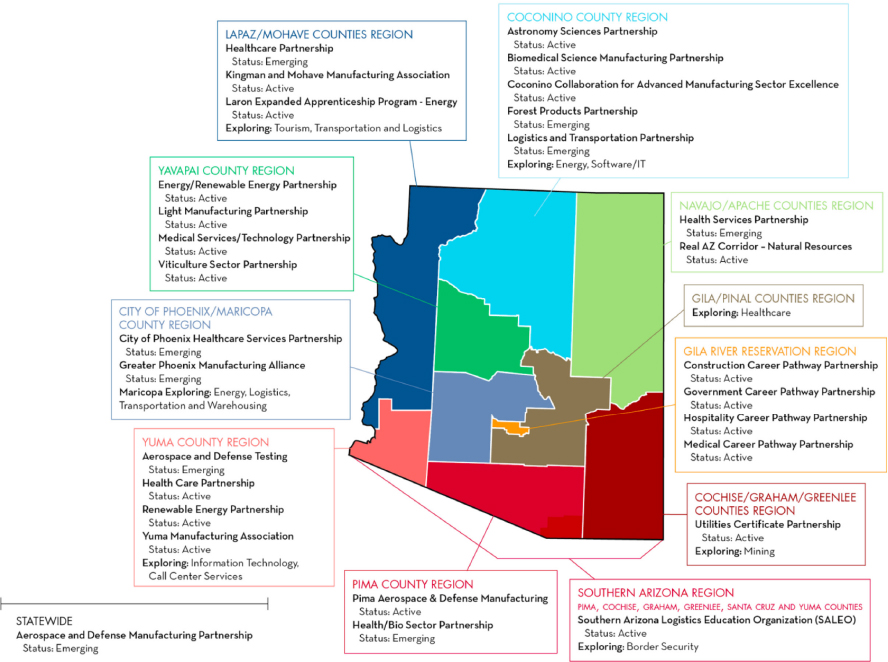C
Examples of Sector-Specific Strategies
MASSACHUSETTS: THE COMMONWEALTH CORPORATION
Massachusetts was the first state to formalize sector strategy work and now has more than three decades of experience. In 1981 civic leaders formed a public–private partnership, the Bay State Skills Corporation, to fund local workforce development initiatives across the state in important industries, requiring a 50 percent matching contribution from employers.
The mission of the Commonwealth Corporation is to strengthen the skills of Massachusetts’ youth and adults by investing in innovative partnerships with industry, education, and workforce organizations (Commonwealth Corporation, 2014).1 In partnership with 8 state government offices, 16 regional Workforce Investment Boards, and 10 corporate and foundation partners, it allocated $48.6 million in 2014 to addressing the workforce training needs of businesses, unemployed workers, and youth.
The corporation’s Workforce Competitiveness Trust Fund (WCTF) is an example of its partnership model in practice. In an effort to build regional capacity to address the gap between the skills held by unemployed and underemployed workers and the skills needed by employers, the WCTF made grants to 15 partnerships across the state. These partnerships involved more than 100 businesses, as well as regional stakeholders from community colleges, vocational technical schools, community-based organizations, workforce investment boards, career centers, and organized labor.
__________________
1 In 1996, BSSC merged with the Industrial Service Program to form the Commonwealth Corporation, which is a quasi-public corporation of the Commonwealth of Massachusetts.
AUTOMOTIVE MANUFACTURING TECHNICAL EDUCATION COLLABORATIVE (AMTEC)
AMTEC is an example of a large, cross-state sector partnership that integrates federal, state, and private investments in skilled technical workforce development. Established in 2005 with a grant from the National Science Foundation’s (NSF) Advanced Technical Education (ATE) program to the Kentucky Community and Technical College System, AMTEC is a collaboration of community and technical colleges and industry partners that aims to prepare technicians and engineers for work in automobile manufacturing and technology. AMTEC is one of 42 NSF ATE centers.2
Today AMTEC has 13 active community college and technical education partners and 15 industry partners located across eight states.3 Industry partners include American, Asian, and German automakers and suppliers and the United Auto Workers. The sector partnership identifies worker skill needs across critical job classifications. Using a career pathway approach, AMTEC develops standardized coursework that is modular, flexible, and relevant to local contexts, and it produces “stackable” credentials. Colleges and organized labor work with manufacturers in their local area to customize training consistent with standardized curricula and credentials.
ARIZONA COMMERCE AUTHORITY
The Arizona Commerce Authority, a statewide economic development organization overseen by a public–private board, established the Workforce Arizona Council (WAC) to strengthen the workforce system and address a variety of industry workforce needs using sector strategies. WAC provides customized, intensive technical assistance to local areas, embedding sector strategies into plans, grants, and guidance for workforce plans, apprenticeships, and career pathway programs.
In 2013, Arizona had active or emerging sector partnerships in 11 counties in a wide range of sectors that depend on skilled technical occupations (see Figure C-1). For example, the Cochise Utilities Sector Partnership was established after the Sulphur Springs Valley Electric Corporation reached out to six other local utilities struggling to fill needed line worker positions. In response, the Arizona Workforce Connection worked with Cochise Community College to develop new courses and a certificate program to prepare local candidates, improve the talent pipeline, and provide long-term jobs for the
__________________
2 For information about the NSF ATE program, see NSF (n.d.).
3 AMTEC currently has active partners in Alabama, Kentucky, Michigan, Ohio, South Caroline, Tennessee, Texas, and West Virginia. For information on AMTEC, see AMTEC (n.d.).
community. Similarly, the Coconino Advanced Manufacturing Partnership is an association of 16 of the region’s leading manufacturers that identified shared opportunities and requirements for growth in their sector. Working with regional partners to address workforce and training needs, the group has organized quarterly roundtables, developed incumbent worker training programs, and spearheaded a rebranding campaign to develop greater interest in careers in manufacturing (Arizona Commerce Authority, n.d.).





